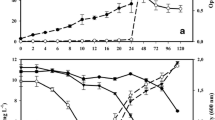Abstract
The primary focus of this research was an assessment of the external carbon source (RCS5, RCS15, and TPA5) as environmentally friendly, alternative of the carbon sources in the denitrification process. These alternative carbon sources (RCS5, RCS15, and TPA5) demonstrated the same grade of biodegradability and denitrification rate. The nitrogen removal efficiencies of RCS5, RCS15, and TPA5 in field application test were 77.4%, 58.7%, and 62.4%, respectively. The application of the alternative carbon sources (RCS5, RCS15, and TPA5) to sewage from K, N and S-STP facilities reduced the cost of an alternative carbon source more than 55.4% when compared with methanol application.
Similar content being viewed by others
References
Choi, E. H., Woo, H. J., Ko, J. H., Poo, K. H., and Kim, C. W. (2002). “Capacity test of various external substrates for denitrification.” Journal of Korean Society of Environmental Engineers, Vol. 24, No.9, pp. 1561–1568.
Elefsiniotis, P. and Li, D. (2006). “The effect of temperature and carbon source on denitrification using volatile fatty acids.” Biochemical Engineering Journal, Vol. 28, No. 2, pp. 148–155.
Jung, Y. J., Koh, H. W., Shin, W. T., and Sung, N. C. (2006). “A novel approach to an advanced tertiary wastewater treatment: Combination of a membrane bioreactor and an oyster-zeolite column.” Desalination, Vol. 190, No. 1–3, pp. 243–255.
Katarzyna, K. and Bram, K. (1999). “A method to estimate denitrification potential for predenitrification systems using NUR batch test.” Water Research, Vol. 33, No. 10, pp. 2291–2300.
Louzeiro, N. R., Mavinic, D. S., Oldham, W. K., Meisen, A., and Gardner, I. S. (2003). “Process control and design considerations for methanolinduced denitrification in a sequencing batch reactor.” Environmental Technology, Vol. 24, pp. 161–169.
Mora, F. R., Ferrara de Giner, G., Andara, A. R., and Esteban, J. L. (2003). “Effect of organic carbon shock loading on endogenous denitrification in sequential batch reactors.” Bioresource Technology, Vol. 88, No. 3, pp. 215–219.
Quan, Z. X., Jin, Y. S., Yin, C. R., Lee, J. J., and Lee, S. T. (2005). “Hydrolyzed molasses as an external carbon source in biological nitrogen removal.” Bioresource Technology, Vol. 96, pp. 1690–1695.
Author information
Authors and Affiliations
Corresponding author
Rights and permissions
About this article
Cite this article
Jung, B., Jung, I. & Sung, N. Development of alternative external carbon source for advanced sewage treatment system and its field applicability assessment. KSCE J Civ Eng 14, 149–154 (2010). https://doi.org/10.1007/s12205-010-0149-x
Received:
Accepted:
Published:
Issue Date:
DOI: https://doi.org/10.1007/s12205-010-0149-x




